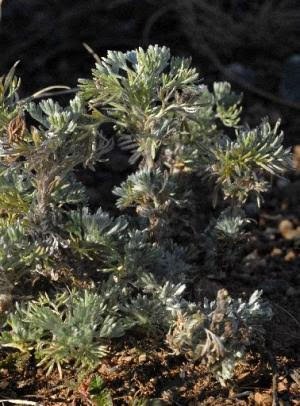December Nature Almanac: Sage—A Symbol for the Season but not for Seasoning
By Ruth Carol Cushman, with Stephen R. Jones and Scott Severs
December 2023
All the various sage species (Artemisia sp.) emit a mouth-watering scent, but they are not the herb for seasoning meats. Salvia officinalis (in the mint family) is the culinary sage, and substituting local Artemisia for Salvia is not recommended. In fact, the volatile oils in some Artemesia species can be poisonous in large doses. A friend of ours once seasoned her Thanksgiving turkey with wild sage. The result was consigned to the garbage!
Silver sage (Artemisia frigida) sprouts fragrant green leaves in the foothills as early as December, so we hail its appearance as a symbol of renewal. Prairie or pasture sage (Artemisia ludoviciana) retains its greenish-white leaves throughout the winter. A bundle of its twigs is sometimes burned to celebrate the winter solstice (this year on December 21st).
Silver or fringed sage begins sprouting green leaves in late fall. Photo courtesy of Stephen Jones.
Aromatic smoke drifting up from burning sage has long been an essential part of purification rites for the Lakota, Arapahoe, and other American Indian tribes. Dancers performing the sacred sun dance usually wear sprigs of sage. The Cheyenne spread sage branches around ceremonial lodges and burn the leaves as incense to drive away evil influences or bad dreams.
Traditionally, many tribes burned prairie sage in sweat-lodges, and people who broke taboos often bathed in sage or rubbed the leaves on their body. Utensils and dishes were wiped with sage to purify them. The Kawaiiisu, a California tribe, threw the seeds into the fire to explode like firecrackers during celebrations.
Pasture or prairie sage retains its aromatic leaves throughout the winter. Photo courtesy of Stephen Jones.
These versatile herbs were widely used in remedies for colds, fevers, arthritis, headaches, sinus attacks, sore throats, stomachaches, menstrual problems, and other ailments. Sage also served as a deodorant and was burned as a disinfectant or to discourage mosquitoes.
Cultures around the world have long believed in the curative and protective powers of various species of sage. In 1597, English herbalist John Gerard wrote:
“Pliny saith, That the traveler or wayfaring man that hath the herbe tied about him feeleth no wearisomnesse at all and… can be hurt by no poysonsome medicines, nor by any wilde beast.”
Ancient druids are thought to have smoked mugwort or wormwood (other common names for Artemisia species) to invoke psychic powers.
Sages, members of the sunflower family, have sweetly pungent leaves that are usually a soft shade of gray-green. The inconspicuous flowers are yellow, brownish, or greenish. The US Department of Agriculture classifies both herbaceous sages and sage brushes (woody shrubs) in the genus Artemisia, named for the wife of King Mausolaus whose tomb was one of the Seven Wonders of the Ancient World. Queen Artemisia was probably named for the Greek goddess of the moon, hunting, and wild animals.
In 2020, Jim Borland wrote a three-part series on the woody sage brushes in Aquilegia, the magazine of the Colorado Native Plant Society (links to all three articles at the end). Borland says woody sage brushes are the most widely distributed shrub in the western US. They cover nearly 270 million acres and range from sea level to 11,500 feet and often receive only 8 inches of annual precipitation.
Ranchers and federal agencies have waged war against sagebrush for decades because it impacts grazing habitat. Recently, however, range managers have worked to restore it in parts of the West because sage grouse are totally dependent on it for survival as they exclusively feed on it in the winter. In 1965, ornithologists Bailey and Niedrach wrote that efforts to help the grouse would be useless “if the fragrant sage, upon which the grouse depends for food and shelter, is destroyed.”
Other December Nature Events
Flocks of Cackling and Canada geese, often numbering over a thousand, form Vs in the sky and forage in fields for grain. Check out those flocks—you might spot a Snow Goose in their midst.
Dippers move down from the high county. They bob up and down searching for bug bits in city creeks. Red Crossbills, Clark's Nutcrackers, and Red-breasted Nuthatches may invade the foothills if conifer cone crops are bountiful.
Mule deer mating season ends. Bucks start to lose their antlers and join the yearlings in bachelor groups, moving away from the does and fawns.
The Boulder Christmas Bird Count takes place on Sunday, December 17. Check the our event page for details.
Sources
This column is based on an article we wrote for The Boulder Camera in 2011.
Bailey, A.M. and R.J. Niedrach. 1965. Birds of Colorado. Volume 1. Denver Museum of Natural History, Denver, Colorado.
Borland, Jim. 2020. Garden Natives: The Woody Artemisias: An Introduction to the Species. Aguilegia 44.4
Borland, Jim. 2021. Garden Natives: The Woody Artemisias: Leaf Morphology and Physiology Part 2. Aguilegia 45.1.
Borland, Jim. 2021. Garden Natives: The Woody Artemisias: The Species and Their Propagation: Part 3 Aquilegia 45.2.
Gerard, John. 1597. The herball or generall historie of plantes.


